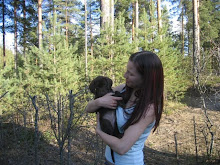
Food allergies make up about ten percent of all the allergies occurring in dogs and cats, coming in after inhalants and flea bites. Many people feel that diets based on lamb and rice are helping them treat or prevent allergies in their pets, but they may not be. We don't really understand how dogs become sensitive to particular foods or food ingredients. Fortunately, there are still plenty of things we do know. Let's look at the way we diagnose food allergies, how we treat them, and what the symptoms are.
Unlike inhalant allergies, there isn't a strong link between a dog being a particular breed and developing particular allergies. Male and female animals are equally affected, and neutering seems to have no effect. Allergies can show up as young as five months of age, and as late as twelve, but most dogs show their symptoms between the ages of two and six. The majority of animals with allergies to foods will also have other allergic reactions as well.
We do need to distinguish between real allergies and mere food intolerances. Food allergies involve skin problems and itching, while food intolerances tend to involve digestive issues and don't have a standard allergic response. Fortunately, the best way to treat both types of problem is to remove the food causing the allergy or insensitivity from the diet.
There are a number of ingredients that are most likely to cause allergies, including dairy, wheat, corn, chicken, eggs, soy and beef. Of course, these are also the most common ingredients in dog food. The incidence of reactions is likely associated with exposure. Lamb and rice diets have been produced to attempt to combat allergies, but there is nothing special about those ingredients except that they are uncommon in pet foods. If lamb and rice become the most common ingredients, more dogs will have reactions to them.
Most allergies in dogs have the same symptom - itchy skin. Other symptoms that come up often include scratching, skin infections, hair loss and chronic ear infections. Dogs with allergies may also have more bowel movements than non allergic dogs. Unfortunately, the fact that most allergies appear the same means that it can be hard to tell what your dog is allergic to. If your pet has recurrent ear problems, has allergies year round, has moderate to severe skin problems or doesn't respond to steroid or antihistamine treatment, food allergies might be the culprit.
Once you've ruled out all other causes of allergy and have determined the problem is definitely food, it's time to do a food trial. The method used is to feed a new source of protein and carbohydrates for twelve weeks, using foods the animal has not eaten in the past. Venison and potato, rabbit and rice, and duck and rutabaga have all been used by people making homemade diets. There are some commercial diets, too.
The pet must eat nothing else for twelve weeks, even treats. If the symptoms disappear or are reduced, the next step is to try the old food again, to make sure they return. If this happens, a food allergy is confirmed. Blood tests and skin testing may also be performed, and once a positive diagnosis is made, you can then choose a new commercial diet or a homemade diet to prevent allergies from happening again. Specific ingredients can be tested one at a time till you find the perfect diet for your pet.
Article by Kelly Marshall of Oh My Dog Supplies your top spot to buy orthopedic dog beds online.
Article Source: http://EzineArticles.com/?expert=Kelly_Marshall


No comments:
Post a Comment